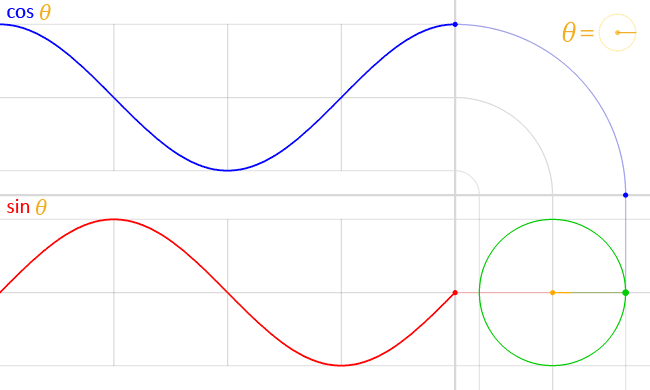文件:Circle cos sin.gif
Circle_cos_sin.gif (650 × 390 像素,檔案大細:517 KB ,MIME類型:image/gif、循環、60格、6.0 s)
注意:因為技術限制,呢個高解像GIF圖嘅縮圖唔係動態。
呢個檔案係出自維基同享,可以喺其他計劃中使用。 佢響嗰邊嘅檔案描述頁響下面度顯示。
摘要
| 描述Circle cos sin.gif |
English: We have the unit circle (with radius = 1) in green, placed at the origin at the bottom right.
In the middle of this circle, in yellow, is represented the angle theta (θ). This angle is the amount of counter-clockwise rotation around the circle starting from the right, on the x-axis, as illustrated. An exact copy of this little angle is shown at the top right, as a visual illustration of the definition of θ. At this angle, and starting at the origin, a (faint) green line is traced outwards, radially. This line intersects the unit circle at a single point, which is the green point spinning around at a constant rate as the angle θ changes, also at a constant rate. The vertical position of this point is projected straight (along the faint red line) onto the graph on the left of the circle. This results in the red point. The y-coordinate of this red point (the same as the y-coordinate of the green point) is the value of the sine function evaluated at the angle θ, that is:
As the angle θ changes, the red point moves up and down, tracing the red graph. This is the graph for the sine function. The faint vertical lines seen passing to the left are marking every quadrant along the circle, that is, at every angle of 90° or π/2 radians. Notice how the sine curve goes from 1, to zero, to -1, then back to zero, at exactly these lines. This is reflecting the fact sin(0) = 0, sin(π/2) =1, sin(π) = 0 and sin(3π/ 2) -1 A similar process is done with the x-coordinate of the green point. However, since the x-coordinate is tilted from the usual convention to plot graphs (where y = f(x), with y vertical and x horizontal), an “untilt” operation was performed in order to repeat the process again in the same orientation, instead of vertically. This was represented by a “bend”, seen on the top right. Again, the green point is projected upwards (along the faint blue line) and this “bent” projection ends up in the top graph’s rightmost edge, at the blue point. The y-coordinate of this blue point (which, due to the “bend” in the projection, is the same as the x-coordinate of the green point) is the value of the cosine function evaluated at the angle θ, that is:
|
|||
| 日期 | ||||
| 來源 | 自己作品 | |||
| 作者 | Lucas Vieira | |||
| 許可 (重用呢個檔案) |
|
Captions
creator 英文
some value
16 3 2014
image/gif
529,197 字節
duration 英文
5.999999999999995 秒
390 像素
650 像素
檔案歷史
撳個日期/時間去睇響嗰個時間出現過嘅檔案。
| 日期/時間 | 縮圖 | 尺寸 | 用戶 | 註解 | |
|---|---|---|---|---|---|
| 現時 | 2014年6月24號 (二) 02:32 |  | 650 × 390(517 KB) | wikimediacommons>LucasVB | Reverted to version as of 15:59, 16 March 2014 |
檔案用途
以下嘅1版用到呢個檔:
